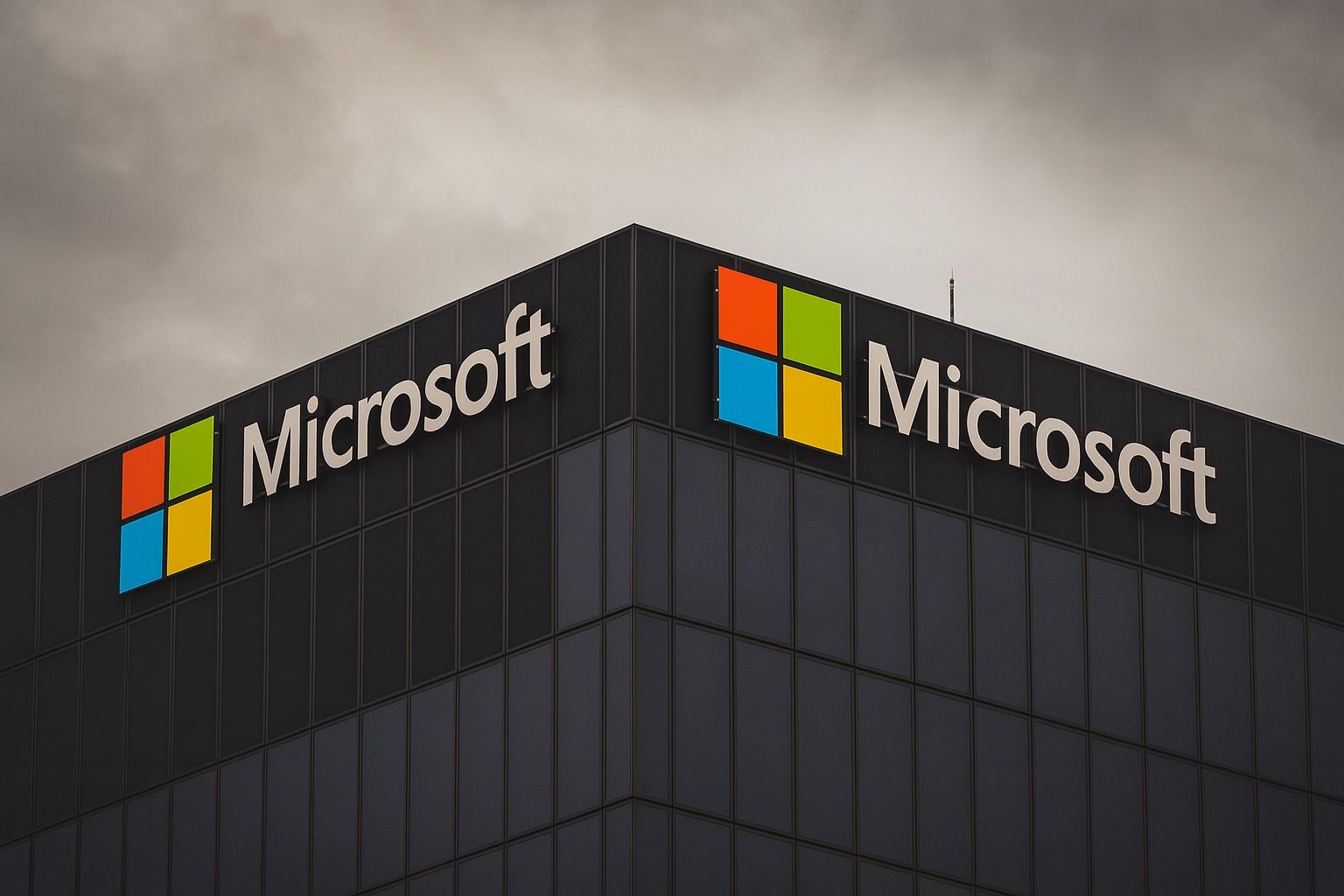What to Know Before Markets Open on October 20, 2025
- Stock near record highs: Microsoft (NASDAQ: MSFT) closed around $514 on Friday, Oct. 17, 2025, just shy of its all-time high (~$555) and up about +23% from a year ago [1] [2]. Its market value stands near $3.8 trillion, cementing Microsoft as one of the world’s most valuable companies [3].
- Strong financials: Microsoft’s fiscal 2025 (year ended June) revenue jumped 15% to $281.7 billion, with Azure cloud sales up 34% [4]. June-quarter earnings beat estimates (EPS $3.65 vs $3.35 expected) amid 18% YoY revenue growth [5]. The company will report its next results on Oct. 29, 2025, keeping investors eager for new guidance.
- All-in on AI: The tech giant is aggressively investing in artificial intelligence and cloud infrastructure. In recent weeks, Microsoft inked a 5-year, $17.4 billion AI supercomputer deal with Nebius to secure tens of thousands of Nvidia GPUs [6]. It also joined Nvidia and BlackRock in a $40 billion consortium to acquire Aligned Data Centers, a massive bet on expanding capacity for AI workloads [7]. A new partnership with the London Stock Exchange Group (LSEG) will embed 33 petabytes of financial data into Microsoft’s AI Copilot platform [8], showcasing the company’s push into finance AI services.
- Leadership shakeup for “tectonic” shift: CEO Satya Nadella recently reorganized Microsoft’s ranks to focus on AI. He appointed Judson Althoff as CEO of the commercial business, freeing Nadella to concentrate on “datacenter buildout, systems architecture, AI science, and product innovation.” Nadella described the AI era as a “tectonic AI platform shift” requiring Microsoft to “build the new frontier” while growing its core business [9].
- Bullish outlook: Wall Street remains overwhelmingly positive on MSFT. 32 of 34 analysts rate it a “Buy,” and the consensus 12-month price target is ~$618 – about 20% above current levels [10] [11]. Some bullish forecasts range even higher (targets $650–$710), citing Microsoft’s dominance in cloud and AI [12]. Wedbush’s Dan Ives, for example, sees Microsoft on a path toward a $5 trillion valuation as its AI endeavors scale up [13].
Stock Near Highs on Strong Performance
Microsoft’s stock has been on a tear in 2025, hovering near record levels after a robust year of growth. Shares ended last week around $513–$514 [14], not far from the all-time closing high of ~$555 set in late July [15]. This rally has added hundreds of billions to Microsoft’s market capitalization, which now sits just under the $4 trillion milestone [16]. The stock has climbed roughly 23% over the past 12 months [17], outpacing the broader market amid excitement over artificial intelligence and resilient demand for cloud services.
Recent financial results underpin this optimism. In its fiscal 2025 (ended June), Microsoft delivered double-digit growth across key segments [18]. Revenue rose to $281.7 billion (up 15% YoY) and operating income hit $128.5 billion (+17%), as the company benefited from booming cloud-computing usage and AI-related software sales. The April–June quarter (Q4 FY25) topped expectations with $76.4 billion in sales (+18% YoY) and earnings of $3.65 per share (comfortably beating analyst estimates of ~$3.35) [19]. CEO Satya Nadella highlighted that “Microsoft Cloud surpassed $168 billion in annual revenue” in FY25, up 23% year-on-year [20] – an indicator of the enormous scale and momentum in Azure, Office 365, and other cloud offerings.
Crucially, Azure remains a growth engine. Azure’s revenue grew 39% in the latest quarter [21], accelerating as businesses large and small ramp up spending on AI and digital transformation. That growth rate outpaced rivals – for comparison, Amazon’s AWS grew ~17% and Google Cloud ~32% in the same period [22] – suggesting Microsoft is gaining cloud market share. Productivity software also contributed: commercial Office 365 sales rose 16%, and consumer subscriptions (Microsoft 365) jumped 21% in the June quarter [23]. Even LinkedIn posted 9% higher revenue with user engagement at record levels [24]. Meanwhile, Microsoft’s gaming division (now bolstered by its acquisition of Activision Blizzard) saw Xbox content and services revenue rise 13% [25]. These broad-based gains show Microsoft firing on multiple cylinders.
Investors will soon get an update on whether this strength is continuing. The company is scheduled to report fiscal Q1 2026 earnings on October 29, 2025 [26]. Analysts expect solid growth but will be scrutinizing the outlook, especially any commentary on AI services demand and the cost of building new data centers. Microsoft’s Chief Financial Officer Amy Hood has signaled that capital expenditures are ramping up to “record” levels – roughly $30 billion for the upcoming quarter [27] – as the firm pours money into AI supercomputing infrastructure. That heavy investment could pinch near-term margins and cash flow [28]. However, Microsoft emphasizes these costs are necessary to meet booming cloud demand and will pay off over time through higher efficiency and future revenues [29]. In the words of one analyst, the company “remains resilient” with diversified businesses that can buffer the huge AI spend while positioning it for long-term growth [30].
AI & Cloud Initiatives Drive the Rally
The excitement propelling Microsoft’s stock is largely centered on its aggressive push into artificial intelligence and cloud computing. In 2023, Microsoft grabbed headlines for its partnership with OpenAI and the launch of the GPT-powered Copilot assistant in apps from Office to GitHub. That AI momentum has only grown in 2025. Microsoft is doubling down on big-ticket deals and infrastructure to ensure it stays at the forefront of the AI era.
One of the most eye-popping deals was with Nebius, a rising star in AI cloud services. In September, Microsoft inked a 5-year, $17.4 billion contract with Nebius to access the company’s high-performance cloud infrastructure and over 100,000 Nvidia GPUs [31]. The partnership triggered a frenzy – Nebius’s stock jumped 44% in a day on the news [32] – and underscores how serious Microsoft is about securing the raw computing power needed for AI. The deal can even expand to $19.4 billion over time [33], illustrating Microsoft’s willingness to spend big to alleviate a critical bottleneck: the shortage of AI chips and server capacity. Essentially, Microsoft is outsourcing some AI workload to Nebius (and likely other partners) to augment its own Azure data centers [34]. Analysts say this validates Nebius’s technology and gives Microsoft a valuable ally as it races to build enough AI infrastructure [35]. It’s a new twist on cloud strategy – even a company with Azure’s scale is tapping external specialists to meet insatiable AI demand.
Microsoft is also making headline-grabbing investments on the data center front. In mid-October, news broke that a consortium of Microsoft, Nvidia, and BlackRock agreed to acquire Aligned Data Centers for roughly $40 billion [36]. Aligned is a major data center operator, and this deal (one of the largest ever in that industry) speaks volumes about the “early innings” of the AI infrastructure build-out [37]. By purchasing data center capacity outright alongside Nvidia, Microsoft can secure more space and power for cloud growth – and perhaps do so more efficiently via partnership. It’s a sign that the supply of server space has become strategic: with AI models requiring thousands of GPUs and vast electricity, tech giants are literally buying up the infrastructure needed to keep growing. This follows other expansions, including Microsoft’s plan to spend $80 billion on AI data centers globally (about half in the U.S.) over several years [38] [39]. The company is already deploying cutting-edge hardware; Azure recently revealed a new supercluster using Nvidia’s latest “Blackwell” GPUs, with over 4,600 of these chips in the first cluster and more on the way [40]. Clearly, Microsoft is determined to avoid being constrained by capacity as AI usage skyrockets.
On the product side, Microsoft continues weaving AI into its offerings. Just last week, it announced an expanded alliance with the London Stock Exchange Group (LSEG). This will allow Microsoft’s AI Copilot to tap into LSEG’s vast trove of financial market data (33+ petabytes of “AI-ready” content) to help bankers and investors with real-time analysis [41]. The partnership, an extension of Microsoft’s earlier $2 billion stake in LSEG, strengthens Azure’s position in financial services and could drive new cloud usage from that sector. Microsoft is also teaming up with fintech firms like Checkout.com (announced Oct. 7) to embed Azure’s AI and cloud tools into digital payments and e-commerce [42]. And in the consumer realm, the Xbox division is leveraging Microsoft’s $69 billion Activision Blizzard acquisition: the company noted it plans to bring popular games (e.g. a new Ninja Gaiden title) to Game Pass and had 50+ million Game Pass subscribers as of FY25 [43] [44]. In short, from finance to gaming, Microsoft is extending its AI and cloud footprint through high-profile deals and product enhancements.
Microsoft’s internal reorganization also reflects its “all-in” approach to AI. On Oct. 1, Satya Nadella made a bold leadership change: he promoted longtime executive Judson Althoff to a new role as CEO of Microsoft’s commercial business, which oversees about 75% of the company’s revenue [45] [46]. By handing off day-to-day management of sales and marketing to Althoff, Nadella freed himself (and key engineering leaders) to focus on what he called Microsoft’s “highest ambition technical work” – namely building AI infrastructure and advanced products [47]. “We are in the midst of a tectonic AI platform shift,” Nadella told employees, one that requires simultaneously growing the core business and inventing “the new frontier” [48]. In practice, this means Nadella is spending more time on things like data center design, AI model R&D, and big-picture product innovation. The restructuring also unified teams across engineering and operations under Althoff, aiming to “tighten the feedback loop” between customer needs and engineering as Microsoft races ahead in AI [49] [50]. Analysts have noted this move signals how crucial AI is to Microsoft’s future – essentially, the CEO is turning his attention to winning the AI race, much like a founder might in a startup during a pivotal moment [51]. Some even speculate Althoff’s new title positions him as a potential heir apparent, though for now the focus is on execution, not succession [52].
Not everything has been smooth sailing – Microsoft faces fierce competition in AI and some partnership growing pains. Notably, OpenAI, the creator of ChatGPT and a linchpin of Microsoft’s AI strategy, has been spreading its wings. Microsoft’s exclusive rights to OpenAI’s tech aren’t permanent, and OpenAI has recently struck deals to diversify its cloud providers. In fact, The Information reported that OpenAI’s leaders feel Microsoft “isn’t moving fast enough” in adding AI server capacity, prompting OpenAI to use other clouds like Oracle and even consider its own infrastructure [53]. OpenAI will also share only 8% of its revenue with Microsoft by 2030 (down from 20% today), a sign that the startup plans to rely less on Microsoft as it grows [54]. This doesn’t mean a breakup – Microsoft still has a strong partnership and a major equity stake in OpenAI – but it shows that even allies can become more self-reliant in the quest for AI supremacy. Microsoft has also reportedly paused some data center projects earlier in the year, after investing over $50 billion in capex in 2024, as it reassessed how to balance supply with demand [55] [56]. The massive upfront costs and power needs of AI are causing every player to plan carefully. Industry watchers note that only ~5% of companies have fully scaled AI deployments so far, so there may be a longer runway than hype suggests [57]. But Microsoft’s bet is that these investments – however costly now – will cement its position as a leader when AI truly goes mainstream. As one expert put it, the company is not having “second thoughts” on AI; it’s just “pragmatically managing” a volatile boom [58]. Crucially, Azure’s ~30% growth (faster than peers) indicates Microsoft is executing well despite the challenges [59]. The company’s diversified businesses (spanning cloud, software, hardware, gaming, and more) also provide a buffer against any single AI risk [60].
Wall Street Stays Bullish on MSFT
Amid these developments, Wall Street’s sentiment on Microsoft remains resoundingly upbeat. The stock is widely seen as a winner of the AI revolution, and analysts argue that its premium valuation is justified by strong fundamentals and growth prospects. According to MarketBeat data, 32 out of 34 analysts currently have a “Buy” or equivalent positive rating on MSFT [61]. The average 12-month price target is about $618 per share [62], implying roughly +20% upside from today’s price. Price forecasts range from around $475 on the conservative end to as high as $700 from the most bullish calls [63]. For instance, 24/7 Wall St. reports the median target is ~$626 and notes that 33 of 34 analysts covering Microsoft rate it a Buy [64] – an almost unheard-of level of agreement for a $3+ trillion company.
The bullish thesis centers on Microsoft’s positioning in key high-growth areas. “Microsoft is becoming more of a cloud infrastructure business and a leader in enterprise AI,” says Gerrit Smit, a strategist at Stonehage Fleming [65]. Many analysts highlight Azure’s accelerating growth and Microsoft’s integration of AI across its product suite as major competitive advantages. Morgan Stanley recently named MSFT one of its “Top Picks,” raising its price target to $625 and praising the company’s cloud and AI “growth trajectory” [66]. Even typically cautious voices see strength: value-oriented stock models give Microsoft high marks for its financial quality. A Warren Buffett-style fundamental screen (from Validea) recently rated MSFT an 86% fit, citing the company’s predictable earnings, high returns on equity, abundant free cash flow, and sensible use of capital – all traits prized by long-term investors [67]. The only knock was Microsoft’s lofty stock price relative to current earnings (the model’s “initial rate of return” criterion), but its expected future returns still passed the test [68]. In fact, despite the stock’s big run, Microsoft’s forward price-to-earnings ratio is about 28×, which some argue is reasonable given Wall Street predicts ~16% annual earnings growth ahead [69]. By comparison, many mega-cap tech peers trade at similar or higher multiples for slower growth.
Of course, not everyone is unreservedly bullish – a few analysts and investors urge caution about exuberant expectations. There are murmurs of an “AI bubble” in some corners of the market, with skeptics noting that valuations of AI-exposed stocks have surged so fast that any stumble in growth could trigger a pullback [70]. Executives at TSMC (a major chipmaker) even drew parallels to the dot-com era recently as they discussed the frenzied demand for AI chips [71]. Microsoft is not immune to those concerns: if corporate AI adoption slows or profit margins suffer from excessive spending, sentiment could cool. Moreover, as discussed, Microsoft faces competition in cloud/AI from the likes of Amazon, Google, and now Oracle (which just won a big piece of OpenAI’s business). Still, the prevailing view on Wall Street is that Microsoft’s advantages outweigh these risks. Wedbush Securities’ Dan Ives – one of the most vocal tech bulls – has projected that Microsoft will join Apple in the $4 trillion market cap club imminently and could approach $5 trillion within 18 months [72] [73]. He and others see the current AI cycle as potentially transformative and still in its early stages [74]. In their eyes, Microsoft’s huge installed customer base and ecosystem give it a long runway to monetize AI, from charging for Copilot features in Office to selling cloud credits for AI training. As long as Microsoft executes, many analysts appear comfortable “buying on dips” and riding what they call a long-term AI-driven uptrend [75].
Technical Analysis and Near-Term Outlook
From a technical market standpoint, Microsoft’s stock has been in a steady uptrend through 2025, and chart watchers see a generally constructive picture. The shares have consistently formed higher lows and have stayed above key moving averages in recent months [76], indicating strong upward momentum. After a brief late-summer pullback, MSFT found support around the $500–$513 level, which coincides with a zone of high trading volume and prior congestion [77]. Indeed, ~$510 has acted as a support floor during October trading. On the upside, the stock faces near-term resistance around $520 [78] – roughly the peak of its early October bounce. A push above $520 on strong volume would be a bullish signal, potentially opening the door for Microsoft to retest its record highs in the mid-$550s. Conversely, if earnings or other news disappoints, traders see the $500 area as an important support; a drop below that could signal a deeper correction, though there’s little sign of that currently.
Momentum indicators are in a healthy range. Microsoft’s Relative Strength Index (RSI) is in the mid-50s (on a 100-point scale) and not yet overbought [79]. Other trend measures like the MACD are positive, reflecting an upward bias, but not at extreme readings that often precede a pullback [80]. In plain English, the stock’s rally has some gas left in the tank from a technical perspective – it’s not looking stretched. “The bulls remain fully in charge,” as one market strategist noted after recent Fed comments turned dovish [81]. Broader market conditions have also been supportive: the S&P 500 and Nasdaq both hit all-time highs in early October [82], lifted by cooling interest rate pressures and enthusiasm for tech and AI-related names. The Federal Reserve’s shift to cutting interest rates this fall (after years of hikes) has improved sentiment for high-growth stocks [83] [84]. Lower rates make future earnings more valuable, helping buoy valuations for companies like Microsoft. It’s a notable macro tailwind as we head into year-end.
Looking ahead, Microsoft’s Oct. 29 earnings report is the next major catalyst on the calendar. Investors will be watching not just the headline numbers, but any commentary on Azure’s growth trajectory, AI demand, and expense outlook. If Azure’s growth remains strong and the company issues confident guidance (while keeping costs in check), it could spur another leg higher for the stock. Many analysts have year-end targets in the mid-$560s to low $600s, which assume Microsoft continues executing well. On the other hand, any sign of cloud growth deceleration or a cautious tone on AI spending could give the market pause – Microsoft’s stock is priced for a lot of good news. Another factor to monitor is the broader tech sentiment: October is also bringing earnings from Alphabet, Amazon, and Apple, and any surprises there (good or bad) can spill over to Microsoft given their sector-wide impact.
In the near term, support at ~$506–$513 and resistance around ~$520 are key levels [85]. A decisive break past $520 would be a bullish confirmation that could quickly put Microsoft back in record-high territory. Beyond $555, some technicians might use round numbers like $575 or $600 as psychological targets. And fundamentally, the analyst consensus target of ~$618 [86] suggests plenty of institutions see upside over the next 12 months. As always, investors should temper near-term predictions with caution – unforeseen macro events or competitive moves can affect even the strongest companies. But at this moment, Microsoft has the wind at its back. It’s benefiting from powerful trends in AI and cloud computing, delivering strong financial results, and enjoying a vote of confidence from both Wall Street and its own leadership. Barring any surprises, Microsoft looks positioned to finish 2025 on a high note, with many betting that the software giant’s best days are still ahead in the emerging AI age.
Sources: Microsoft investor materials; TechStock² analysis [87] [88]; Reuters [89]; 24/7 Wall St. [90] [91]; Nasdaq/MarketBeat [92].
References
1. ts2.tech, 2. ts2.tech, 3. ts2.tech, 4. ts2.tech, 5. ts2.tech, 6. ts2.tech, 7. ts2.tech, 8. ts2.tech, 9. www.reuters.com, 10. ts2.tech, 11. ts2.tech, 12. ts2.tech, 13. ts2.tech, 14. stockanalysis.com, 15. ts2.tech, 16. ts2.tech, 17. ts2.tech, 18. ts2.tech, 19. ts2.tech, 20. ts2.tech, 21. ts2.tech, 22. ts2.tech, 23. ts2.tech, 24. ts2.tech, 25. ts2.tech, 26. ts2.tech, 27. ts2.tech, 28. ts2.tech, 29. ts2.tech, 30. 247wallst.com, 31. ts2.tech, 32. ts2.tech, 33. ts2.tech, 34. ts2.tech, 35. ts2.tech, 36. ts2.tech, 37. ts2.tech, 38. www.geekwire.com, 39. www.geekwire.com, 40. ts2.tech, 41. ts2.tech, 42. ts2.tech, 43. ts2.tech, 44. ts2.tech, 45. ts2.tech, 46. ts2.tech, 47. www.reuters.com, 48. www.reuters.com, 49. ts2.tech, 50. ts2.tech, 51. ts2.tech, 52. ts2.tech, 53. 247wallst.com, 54. 247wallst.com, 55. 247wallst.com, 56. 247wallst.com, 57. 247wallst.com, 58. 247wallst.com, 59. 247wallst.com, 60. 247wallst.com, 61. ts2.tech, 62. ts2.tech, 63. ts2.tech, 64. ts2.tech, 65. ts2.tech, 66. ts2.tech, 67. ts2.tech, 68. ts2.tech, 69. 247wallst.com, 70. ts2.tech, 71. ts2.tech, 72. www.geekwire.com, 73. www.geekwire.com, 74. www.geekwire.com, 75. 247wallst.com, 76. ts2.tech, 77. ts2.tech, 78. ts2.tech, 79. ts2.tech, 80. ts2.tech, 81. ts2.tech, 82. ts2.tech, 83. ts2.tech, 84. ts2.tech, 85. ts2.tech, 86. ts2.tech, 87. ts2.tech, 88. ts2.tech, 89. www.reuters.com, 90. 247wallst.com, 91. 247wallst.com, 92. ts2.tech







